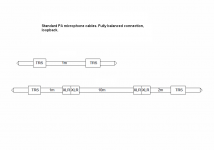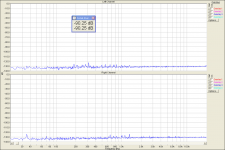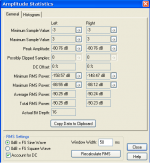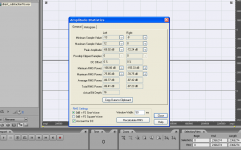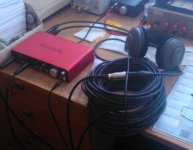Hello all,
I have a new test for you, this time the test variable is a link cable. You will find the (stereo) files at:
https://www.dropbox.com/s/z51j3nr8nk5kum9/rgcardas.zip?dl=0
Please feel free to post your foobar ABX screenshot results or just comment on your preferences.
I have a new test for you, this time the test variable is a link cable. You will find the (stereo) files at:
https://www.dropbox.com/s/z51j3nr8nk5kum9/rgcardas.zip?dl=0
Please feel free to post your foobar ABX screenshot results or just comment on your preferences.
Thanks for you result, Frank.
I am showing what is tested, though files are not disclosed yet.
The only difference between the files is cable length + 2 additional connector connections.
The files are perfectly time aligned. Diffmaker shows 65ns (nanoseconds) time difference, which corresponds to time delay on the longer cable. Cable propagation delay is 5.5ns/m.
The setup is loopback, fully balanced, which results in no hum loop components added. I can post the difference file, if you or the others are interested.
I am showing what is tested, though files are not disclosed yet.
The only difference between the files is cable length + 2 additional connector connections.
The files are perfectly time aligned. Diffmaker shows 65ns (nanoseconds) time difference, which corresponds to time delay on the longer cable. Cable propagation delay is 5.5ns/m.
The setup is loopback, fully balanced, which results in no hum loop components added. I can post the difference file, if you or the others are interested.
Attachments
Direct sample subtraction reflects mostly the time shift between the files. If the subtraction is made by diffmaker, the files are as exactly time aligned as possible and the difference is inaudible:
https://www.dropbox.com/s/bcml39rcuwvy2xt/rg-cardas.wav?dl=0
This is the diffmaker result. I will post a result of direct subtraction in a while.
https://www.dropbox.com/s/bcml39rcuwvy2xt/rg-cardas.wav?dl=0
This is the diffmaker result. I will post a result of direct subtraction in a while.
Attachments
This is the direct subtraction
https://www.dropbox.com/s/5qb067avllpxc18/direct_subtraction16.wav?dl=0
Please take into account that even smallest and constant time difference between times when samples are taken, between the files, makes big sample amplitude differences. In this case, time shift is 65ns due to cable length, which is still acceptable, however, direct subtraction without alignment even in those 65ns says nothing about audibility of the difference.
So Frank, which file is the "long" and which is the "short" cable.
https://www.dropbox.com/s/5qb067avllpxc18/direct_subtraction16.wav?dl=0
Please take into account that even smallest and constant time difference between times when samples are taken, between the files, makes big sample amplitude differences. In this case, time shift is 65ns due to cable length, which is still acceptable, however, direct subtraction without alignment even in those 65ns says nothing about audibility of the difference.
So Frank, which file is the "long" and which is the "short" cable.
Attachments
Don't forget that audio cables are usually dispersive. At lower frequencies the 'propagation' speed varies like sqrt(freq). Fortunately this causes less phase shift as the frequency varies like freq, and most audio cables are short. Hence if you get them time-aligned at 20kHz they will be good enough at 20Hz.PMA said:The files are perfectly time aligned. Diffmaker shows 65ns (nanoseconds) time difference, which corresponds to time delay on the longer cable. Cable propagation delay is 5.5ns/m.
Don't forget that audio cables are usually dispersive. At lower frequencies the 'propagation' speed varies like sqrt(freq).
You are on board with me
I know this.
This is starting to look like a test of DiffMaker as well ... 
DiffMaker obviously got a much deeper null, but, if you amplify the file it produced you can still hear the music! Very noisy, but still the track is audible - demonstrating the power of digital to encode very low level material, .
.
The subtraction file you posted doesn't quite match mine, but is close enough - unfortunately, there are variations in the subtraction file which are not due to some simple time alignment problem; but DiffMaker has discarded them, somehow decided that they didn't matter. In fact, this surfaced when I was assessing that program at an earlier time - its ability to fudge the difference, cleaning up the rough bits and presenting a heavily sanitised version of the truth said to me that it was highly flawed ...
That said, and very especially assuming no confounders - from experience connectors are a weak point, typically degrading quality, so my guess is that the cardas version matches the short cable.
DiffMaker obviously got a much deeper null, but, if you amplify the file it produced you can still hear the music! Very noisy, but still the track is audible - demonstrating the power of digital to encode very low level material,
The subtraction file you posted doesn't quite match mine, but is close enough - unfortunately, there are variations in the subtraction file which are not due to some simple time alignment problem; but DiffMaker has discarded them, somehow decided that they didn't matter. In fact, this surfaced when I was assessing that program at an earlier time - its ability to fudge the difference, cleaning up the rough bits and presenting a heavily sanitised version of the truth said to me that it was highly flawed ...
That said, and very especially assuming no confounders - from experience connectors are a weak point, typically degrading quality, so my guess is that the cardas version matches the short cable.
Okay, we do have confounders then - you indicated earlier that you could hear a difference, via the ABX, was that a valid result, there was an audible difference for you?
Mentioning time alignment, I filtered out below 10kHz, looked at a couple of spots and they correspond to the individual sample. That the subtraction file shows significant results does mean something, and I shall zoom into a couple of places to pick where something interesting is happening, and post it.
Strange pseudo theories about DiffMaker, or connectors? If DiffMaker, sorry to disappoint you - I deliberately dirtied up a file or two, in very specific ways, to see if DiffMaker could pick it ... not a chance, the program's guess was miles off. You see, this is called testing the testing mechanism - a multimeter that is always out by a factor of 10 is not the best thing to put your trust in ... just because there is only one thing that's usable doesn't mean that it's the bees knees ...
Point is, what does the ear hear? A well executed subtraction file, or what DiffMaker has decided that you can hear?
Mentioning time alignment, I filtered out below 10kHz, looked at a couple of spots and they correspond to the individual sample. That the subtraction file shows significant results does mean something, and I shall zoom into a couple of places to pick where something interesting is happening, and post it.
Strange pseudo theories about DiffMaker, or connectors? If DiffMaker, sorry to disappoint you - I deliberately dirtied up a file or two, in very specific ways, to see if DiffMaker could pick it ... not a chance, the program's guess was miles off. You see, this is called testing the testing mechanism - a multimeter that is always out by a factor of 10 is not the best thing to put your trust in ... just because there is only one thing that's usable doesn't mean that it's the bees knees ...
Point is, what does the ear hear? A well executed subtraction file, or what DiffMaker has decided that you can hear?
Tasker C114
Balanced microphone cables : C114 - Tasker AUDIO
(the long cable)
Bespeco Bofors-S
http://www.bespeco.it/prodotto_allegati/boforss_data_eng.pdf
(the short 1m cable)
Balanced microphone cables : C114 - Tasker AUDIO
(the long cable)
Bespeco Bofors-S
http://www.bespeco.it/prodotto_allegati/boforss_data_eng.pdf
(the short 1m cable)
Last edited:
While on the subject of balanced analog interconnect cables & systems, Jim Brown has several excellent papers:
"Pin 1 Revisited"
"Pin 1 Revisited -- Part 2"
"Shield-Current-Induced Noise - Part 1"
"Shield-Current-Induced Noise - Part 2 "
"Common-Mode to Differential-Mode Conversion in Shielded Twisted-pair Cables (Shield-Current-Induced Noise)"
"Testing for Radio-Frequency Common Impedance Coupling (the "Pin 1 Problem") in Microphones and Other Audio Equipment"
"A Novel Method of Testing for Susceptibility of Audio Equipment to Interference from Medium and High Frequency Radio Transmitters"
"Radio Frequency Susceptibility of Capacitor Microphones"
"RF Susceptibility of Condenser Microphones"
All at:
Audio Systems Group, Inc. Publications
"Pin 1 Revisited"
"Pin 1 Revisited -- Part 2"
"Shield-Current-Induced Noise - Part 1"
"Shield-Current-Induced Noise - Part 2 "
"Common-Mode to Differential-Mode Conversion in Shielded Twisted-pair Cables (Shield-Current-Induced Noise)"
"Testing for Radio-Frequency Common Impedance Coupling (the "Pin 1 Problem") in Microphones and Other Audio Equipment"
"A Novel Method of Testing for Susceptibility of Audio Equipment to Interference from Medium and High Frequency Radio Transmitters"
"Radio Frequency Susceptibility of Capacitor Microphones"
"RF Susceptibility of Condenser Microphones"
All at:
Audio Systems Group, Inc. Publications
In the meantime, I have prepared the same test in 24-bit resolution. I assume that 16-bits might not be enough.
https://www.dropbox.com/s/1ht94o7j2pd2s29/kabel_24bit.zip?dl=0
https://www.dropbox.com/s/1ht94o7j2pd2s29/kabel_24bit.zip?dl=0
- Status
- This old topic is closed. If you want to reopen this topic, contact a moderator using the "Report Post" button.
- Home
- General Interest
- Everything Else
- Link cables ABX listening test

